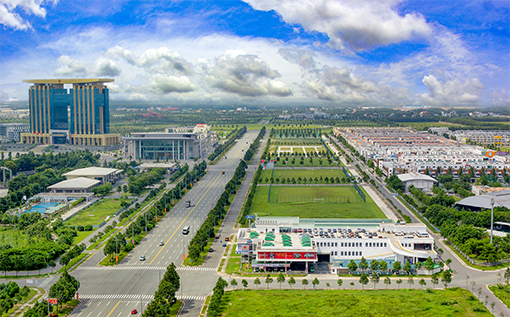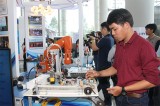To take full advantage of potential to build Binh Duong smart city
Binh Duong is developing smart industrial production and services, perfecting Triple Helix cooperation model. It can be seen that building a smart city is a process, currently Binh Duong has certain advantages to build the smart city efficiently and quickly.
Many advantages, many challenges
With the characteristics of an industrial city, Binh Duong urban area currently has a convenient transportation system, good links with major economic centers in the region, such as Ho Chi Minh City, Dong Nai industrial province, Vung Tau seaport urban services. Besides, transportation system connecting urban areas was established through roads such as National Highway 13, DT741, DT744 ... playing the role of linking southern central cities with satellite cities in the north. Meanwhile, east-west belt roads play the role of connecting central cities in the south and satellite transportation in the north of the province together.
In addition, the public transport system has been strongly invested by the province. The province has developed 20 bus routes with a total length of 714km, the number of vehicles is 223. According to the planning orientation until 2020, the province will develop 11 bus routes, in the period 2021-2025 will be 15 routes, after 2025 will add 14 routes, and encourage the use of environmentally friendly fuels.

Binh Duong New City.
In addition to the development of transport network, provincial post and telecommunications network is also expended, meeting the demand for sending and receiving parcels of people and enterprises in the province. The whole province has 2,272 BTS stations; Fiber optic network has been deployed to 100% of communes and residential areas ...
It is clear that the construction of Binh Duong smart city has many advantages in urban infrastructure. However, industrial development causes the transport system to face the pressure of heavy transport on a continuous basis, leading to vulnerable roads, maintenance costs will be costly.
According to M.S. - Architect Huynh Kim Phap, lecturer of Architecture Faculty of Thu Dau Mot University, industrial production can give material value, environmental challenges are also worth being considered. The green and environmentally friendly industrial production has been developed and applied by many countries, including Vietnam. However, monitoring and analyzing the urban environment in light of impacts of industrial waste is a very important issue.
In fact, industrial cities and investment companies do not properly follow the environmental protection process, which has contributed to environmental damage that difficult, even impossible, to overcome in a short time. On the other hand, the energy source for industrial production is very large, if optimization problems in technology, energy supply conversion, balance of industrial and urban energy production do not receive attention, we cannot reach standards for smart energy.
Recently, in order to develop industry, Binh Duong has mobilized a huge labor force. It is expected that by 2025, the province would have over 1,060 million workers, accounting for more than 60% of the urban population. However, many workers in Binh Duong have low qualifications, they come from many localities throughout the country to make a living. Therefore, maintaining stability and improving intellectual standards for this force is an extremely important issue to the province in the process of smart city building .
To contribute more solutions to build smart urban
According to assessments of Department of Construction, Binh Duong urban area is on a strong development, but there are still many issues must be solved. Regarding smart urban construction in Binh Duong, Architect Van Cong Quang Hieu, Department of Construction, said that the first thing to do is to reform the planning and research method. Accordingly, the planning method must be based on evaluation and analysis of the shared database to propose solutions to environmental protection, protection of resources on land, energy and other natural resources; more effectively using public resources, preserving historical values, ensuring space for education and recreation, limiting rampant development and upgrading urban space ...
M.S. - Architect Huynh Kim Phap proposed, smart city construction needed 3 phases: Phase 1 (a connected city) focuses on building city infrastructure, such as broadband, cloud computing. The result of this phase will be that wired and wireless broadband across the city is quickly built, provides high-speed Internet access. In addition, open access networks have been executed to connect with traffic signal facilities to prepare for the next phase.
The second phase (customized city) encompasses the city's applications, including smart public services and environmental protection sensors, aiming at managing urban changes, domestic waste, street lighting systems, smart car parks ... The third stage is a smart city to build a city management platform and a smart community portal to finally build a complete smart city. The key is that no matter how much investment develops, the urban human factor is still a key component.
Reported by Phuong Le – Translated by Ngoc Huynh
 Binh An Ward launches "Digital Family" program
Binh An Ward launches "Digital Family" program
 Bau Bang launches the Intelligent Monitoring and Operation Center (IOC)
Bau Bang launches the Intelligent Monitoring and Operation Center (IOC)
 Vibrant activities from grassroots level
Vibrant activities from grassroots level
Binh Duong is an active and responsible member of ICF
 Binh Duong aims at building a smart, green and sustainable city
Binh Duong aims at building a smart, green and sustainable city
 Building up an innovation ecosystem at new era’s demands
Building up an innovation ecosystem at new era’s demands
 Abundant activities in response to National Digital Transformation Day
Abundant activities in response to National Digital Transformation Day
 Beca Smart City - The foundation of a Smart City
Beca Smart City - The foundation of a Smart City
 Digital transformation supports social welfare
Digital transformation supports social welfare
 PM requires full legal corridor to promote national digital transformation
PM requires full legal corridor to promote national digital transformation



